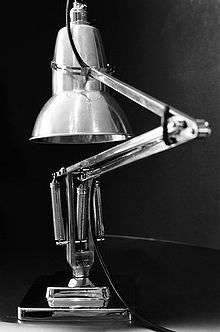Anglepoise lamp

The Anglepoise lamp is a balanced-arm lamp designed in 1932 by British designer George Carwardine.
History and development
Carwardine was a car designer and was, at the time he invented the Anglepoise lamp, a freelance design consultant specialising in vehicle suspension systems. While developing new concepts for vehicle suspensions, he created a mechanism which he recognised had applications in other fields. He particularly saw its benefits for a task lamp. Despite many claims to the contrary, his concept had nothing whatsoever to do with mimicking the actions of the human arm. The joints and spring tension allow the lamp to be moved into a wide range of positions which it will maintain without being clamped.
Carwardine applied for a patent, number 404,615,[1] for a design using the mechanism on 4 July 1932, and manufactured the lamp himself in the workshops of his own company, Cardine Accessories, in Bath, England. He soon found the interest and demand so great that he needed a major expansion or partner and, on 22 February 1934, entered into a licensing agreement with the Terry Spring Company in Redditch, England.[2] Terry's manufactured and marketed the lamp, while Carwardine continued to develop the concept, producing a number of other versions and applications (for example, for supporting microphones). The original four-spring design was made for working environments, such as workshops and doctors' and dentists' surgeries, but he also designed a three-spring version for use in the home (patented on 10 February 1934, patent number 433,617[3]).
1935 saw the release of the 1227 Anglepoise. An effective and revolutionary design, it was primarily manufactured for the home and proved to be extremely popular. When people think of the Anglepoise lamp, this is usually the design which springs to mind. The 1227 was hugely promoted by the Terry Spring Company and when the Second World War broke in 1939, the company ran an advert that same day describing it as the "ideal blackout lamp".[4]
Although the Second World War had a detrimental effect on standard Anglepoise production, the Terry Spring Company switched its objectives to benefit the war effort and, consequently, started producing Anglepoise lamps for bombers. According to the Anglepoise website, these were so well produced that when a crashed bomber was salvaged from Loch Ness in Scotland in 1986, the lamp still worked after being given a new battery - despite being submerged for around four decades.[5]
A key feature of the Anglepoise design and patent is the placement of all springs (either three or four) near the base. The design was extensively copied by other companies, usually in simplified form, and is still in use. Some derivatives use a heavy balance weight instead of the springs. The most common version replaces the arm linkages with two independent parallelogram linkages, with a pair of light tension springs on each half of the arm.
The arm has been employed in other devices where it is necessary to hold an object stationary at a convenient point in space, notably the copy holder for typists and in some applications, the computer display screen.
Although the lamp is still marketed as an iconic British design, production for all lamps, except the 1227 Giant model, has been moved to China.[6]
George Carwardine was born in 1887 and died in 1947, at the age of 60.
Anglepoise lamps at the BBC
In 1948 the Board of Governors of the BBC asked the head of the Variety Department, Michael Standing, to devise a guiding set of moral standards and protocols for the production of all BBC radio and television programmes. Standing produced what became known within the BBC as the "Green Book", whose purpose was to eradicate smut, innuendo and vulgarity from all BBC programmes. After producing the book Standing took to implementing his guidance with eccentric zeal. In June 1949 he issued a memo to all staff in which he forbade BBC employees to illuminate any room with an Anglepoise lamp unless the main ceiling or wall light was also illuminated: Standing held a firm belief that a man working at a desk in a confined space with only the light from a low-wattage lamp would nurture furtive ideas and produce degenerate programme material. Director General Sir William Haley later rescinded the Anglepoise lamp edict as extreme and unnecessary.[7]
In culture
- "(I Wanna Be an) Anglepoise Lamp" 1978 single by the Soft Boys.
- Peter Gabriel's Shock the Monkey 1982 video features "dancing" Anglepoise lamps.
- The protagonist of Salman Rushdie's 1980 novel "Midnight's Children", Saleem Sinai, makes repeated references to the Anglepoise lamp in the light of which he writes.
See also
- Balanced-arm lamp
- Industrial design
- Over-illumination
- The Luxo lamp, a 1937 Norwegian derivative of the Anglepoise design.
References
- ↑ "Patent Specification - Improvements in elastic equipoising mechanisms (GB404615A)". Retrieved 2016-11-13.
- ↑ "Graces Guide - British Industrial History". Retrieved 7 November 2014.
- ↑ "Patent Specification - Improvements to equipoising mechanism (GB433617A)". Retrieved 2016-11-13.
- ↑ "1227". Retrieved 7 November 2014.
- ↑ "Anglepoise". Retrieved 7 November 2014.
- ↑ "The little firm with the bright ideas". www.portsmouth.co.uk. Retrieved 2016-02-20.
- ↑ John Birt, The Harder Path (Time Warner Paperbacks, 2003),p.193.
External links
| Wikimedia Commons has media related to Anglepoise lamps. |
- DesignMuseum.org, The Design Museum page on the lamp and its development / history.
- Anglepoise.co.uk, Makers home page
- The Anglepoise: a History, Harry Langworthy